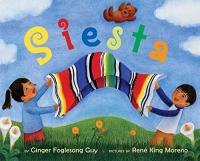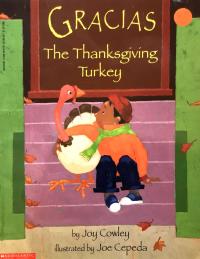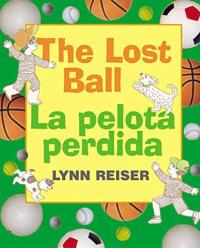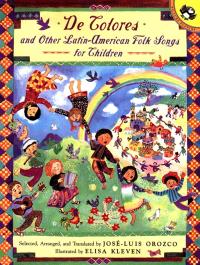
This attractively animated collection of lively songs and rhyming games is a great opportunity to have fun with language! Written in both English and Spanish, this playful book expands your word game repertoire.
Diez Deditos: 10 Little Fingers and Other Play Rhymes and Action Songs from Latin America

Two children prepare for a backyard adventure, taking with them a rainbow of necessities: a blue backpack, a yellow book, even a multi-colored blanket to serve as their tent when they take a nap. The simple adventure is told in uncomplicated sentences presented in Spanish and English, and is illustrated in richly hued, swirling images.
Siesta

Semi-abstract illustrations use bold lines and strong color to accompany and enhance the inviting text that encourages participation both in Spanish and English. Readers are invited to count, find words, and perhaps even sing (music is included) in this winning combination of words and images.
Rin, Rin, Rin/Do, Re, Mi

On a beautiful autumn morning, Xiao Ming, his mom and his friends visit a farm. As they explore the season and the location, Xiao Ming introduces his friends to several Chinese characters. Textured cut paper collage extend the story and the learning.
In the Leaves

In this warm holiday story, a young Puerto Rican boy saves the life of his pet turkey on Thanksgiving with help from his close-knit New York City family and neighborhood. Spanish vocabulary is woven into the text. Spanish version available.
Gracias, the Thanksgiving Turkey

The Festival of Lights, or Hanukkah, celebrates the rededication of the Jewish temple after a group of ancient heroes defended their right to worship as they wished. This handsome little counting book honors the most joyful of Jewish holidays, and teaches readers how to count from one to eight in English, Hebrew, and Yiddish.
Hanukkah: A Counting Book in English, Hebrew, and Yiddish

Adelita’s stepmother and stepsisters relegate her to kitchen duties after her father dies - and they don’t let her attend the fiesta. While details change – a kindly servant takes the place of a fairy godmother and a brightly hued shawl replaces the glass slipper – the story is recognizable as a Cinderella variant. Adelita, published in September of 2002, is rich with the colors, flavors, and sounds of Mexico. Spanish is sprinkled throughout this beautifully decorated book.
Adelita: A Mexican Cinderella Story

Three generations bake a pie, make a crown of flowers, pass on a handmade quilt, and share a lullaby. Each time “it was the same, but different,” highlighting the connections between generations. Vividly colored, child-like illustrations effectively complement the rhythmic text. See also the bilingual version, Tortillas and Lullabies/Tortillas y cancioncitas (opens in a new window).
Cherry Pies and Lullabies

Using the alphabet as a pattern, paintings and brief poems explore rural life in Mexico presented first in Spanish and followed by English. From A to Z, brilliant illustrations and fluid poems evoke the plants, and more and the emotional impact on the lives of farm workers.
Gathering the Sun: An Alphabet in Spanish and English

A girl visits both sets of grandparents on weekends. On Saturdays, she speaks English with Grandpa and Grandma, while on Sundays, los domingos, she speaks Spanish with Abeulito and Abeulita. The format provides a glimpse at the subtle differences between cultures and highlights their similarities, one of which is each set of grandparents’ love for their granddaughter. Spanish words are interspersed in the fluid text.
I Love Saturdays y domingos

Two boys and their dogs look for the balls they have each lost in the park. Not only do they find them, they each find a friend. The text, in Spanish and English, appears in different colors along with crisply lined illustrations, allowing readers to follow Richard and Ricardo on their hunt. When the boys find their balls and discover their shared interests, they (and the colors) come together on a single page. Reiser’s Margaret and Margarita, Margarita y Margaret explores a similar theme as girls and their mothers meet and discover friendship, despite speaking different languages.
The Lost Ball/La pelota perdida

Rosalba imagines flying over New York City with her much loved abuela. The young girl uses a lovely mix of English and Spanish to describe their journey, moving from the busy streets of Manhattan to the Statue of Liberty. Brightly colored illustrations detail what Rosalba and her grandmother glimpse as they fly, and the rich tales of Abuela’s memories.
Abuela

These traditional rhymes and songs from Latin America are presented in both English and Spanish. Gentle illustrations accompany the short verses, and show both cities and the countryside. Children and adults from Spanish-speaking backgrounds will recognize many of these fun songs and rhymes.
Arroz con Leche

Chato and Novio Boy are the coolest cats in their East Los Angeles barrio. When a family of mice moves next door to Chato, he invites them to dinner. He’s going to eat them for dinner, but the mice bring a friend along to surprise Chato and foil his plans. The text and pictures show the funny situation and the satisfying solution. In English sprinkled with Spanish.
Chato’s Kitchen

Bursting with color and spirit, this collection of Latin-American songs is a tribute to Latino culture. From traditional tunes to rhymes and hand games, De Colores has songs for all occasions and moods. Each song is accompanied by simple musical arrangements, with lyrics in both English and Spanish.
De Colores and Other Latin-American Folk Songs for Children

Spanish words are incorporated naturally into this bright collection of poems that depict a day’s activities in the Southwest. Vivid illustrations complement the verse to evoke the author’s Mexican American background.
Confetti: Poems for Children

Kingsville, on the border of Mexico and Texas, comes to life in words and pictures in this book. Readers will share the simple joys of eating, dancing, and celebrating as the artist remembers her own childhood. Her stories, presented in both English and Spanish, are accompanied by her bright paintings.
In My Family / En mi familia

The poet remembers summers growing up in Mexico in poems presented in both English and Spanish. Readers meet his family and join them in the everyday joys of the sunny season. Illustrations are as colorful and evocative as the words.
From the Bellybutton of the Moon and other Summer Poems / Del ombligo de la luna y otros poemas de verano

Thirteen poems rejoice in Latina women, their diversity, and their roles. This short, illustrated collection celebrates Spanish-speaking countries as well as bilingualism in the United States. Illustrations swirl across each page, combining computer generated and traditional art with energetic results.
Love to Mamá: A Tribute to Mothers

It’s market day, and everyone’s going to the town square. But this is no ordinary market — it’s a veritable feast of folk art from around the world, assembled with Lois Ehlert’s impeccable eye for color and design.
Market Day

Look at the moon and what do you see? Could it be Fox? Fox convinced Mole to accompany him to the moon by suggesting that huge worms were there. Mole comes back down to Earth, but Fox may still be up there. This myth from Peru is told in both English and Spanish and is illustrated with shining collages inspired by Peruvian artwork and artifacts.
Moon Rope

Stella and her brothers speak Spanish at home but English at school. Being different is both scary and exciting. Stella learns this when she prepares for the school’s celebration of May Day. She finds a way to honor her Mexican background by wearing a special skirt that is both alike yet different from the other girls’. Stella, like many children, can take pride in being part of two cultures. (In English sprinkled with Spanish).
The Rainbow Tulip

José lives in a diverse neighborhood where he’s just as likely to hear Spanish, English, or Chinese. The appealing photographs in this book document José’s life at home, at school, and on the streets of his colorful barrio in San Francisco, a city that is a dynamic mosaic of different cultures. Available in a Spanish.
Barrio: José’s Neighborhood / Barrio: El barrio de José

Fiestas often involve puppets, masks, and piñatas. Meet Tío Rico, the elderly piñata maker in a Mexican town, whose artful creations are shown from start to finish in this handsomely photographed book. The text is presented in both Spanish and English.
